Warum Individualisierung in der modernen Kleiderbügel-Herstellung wichtig ist
Steigende Nachfrage nach einzigartigen Kleiderbügel-Designs im Einzelhandel und der Bekleidungsbranche
Laut den Retail Insights des vergangenen Jahres konzentrieren sich derzeit etwa 72 Prozent der Bekleidungsmarken auf einzigartige Kleiderbügel-Designs, da die Läden mit ähnlichen Produkten immer stärker überfüllt sind. Neue Maschinen zur Herstellung von Kleiderbügeln ermöglichen es Unternehmen, schnell die unterschiedlichsten ungewöhnlichen Formen zu testen und gleichzeitig umweltfreundliche Materialien wie recycelte Plastikflaschen zu verarbeiten. Küstenresorts erhalten beispielsweise oft jene stylischen wellenförmigen Kleiderbügel für die Präsentation von Bademode. Gleichzeitig wünschen gehobene Geschäfte, dass ihre Ständer edel wirken, etwa durch goldene Flocken in der Oberfläche. Diese besonderen Akzente werden möglich dank Maschinen, die regulieren können, wie Materialien eingespeist werden, sowie Werkzeugen, die je nach Bedarf verschiedene Teile einfach einrasten lassen.
Wie individuelle Kleiderbügel die Markenidentität und Wirkung im Regal stärken
Marken, die auffällige Kleiderbügel anstelle der gewöhnlichen verwenden, verzeichnen laut einer Nielsen-Studie aus dem Jahr 2022 etwa eine 47-prozentige Steigerung der Kundenerinnerung. Ein Bekleidungsunternehmen, das kürzlich mit Denim-Marken zusammenarbeitete, verbesserte die Ladenpräsentation deutlich, indem es Größenangaben direkt in die Bügelarme eingravierte. Dazu verwendeten sie hochwertige PLC-gesteuerte Maschinen für Metallbügel während der Produktion. Das Ergebnis? Die Geschäfte wirkten aufgeräumter, da nicht mehr so viele zusätzliche Etiketten herumhingen, und der Umsatz stieg um nahezu 20 %. Kunden fiel die Kaufentscheidung viel leichter, da sie beim Durchstöbern der Kleiderständer einfach einen Blick auf die Größeninformationen werfen konnten.
Die strategische Rolle der Flexibilität von Kleiderbügelmachmaschinen in der Fast-Fashion
Schnellmodemarken, die anpassungsfähige Kleiderbügelsysteme einsetzen, erreichen 23 % schnellere SKU-Rotationen (McKinsey 2023). Maschinen mit einem Werkzeugwechsel in 90 Sekunden ermöglichen es Einzelhändlern – wie einem großen europäischen Schnellmodemarke – die Produktion von Kleiderbügeln an wöchentliche Farbneuerscheinungen anzupassen. Diese Flexibilität verhindert Überbestände und bewahrt gleichzeitig das hochwertige, handgefertigte Erscheinungsbild, das Verbraucher schätzen.
Anpassung von Kleiderbügelherstellungsmaschinen für verschiedene Größen und Stile
Anpassung von Werkzeugen und Formen für variable Kleiderbügelabmessungen
Moderne Kleiderbügelherstellungsmaschinen verwenden verstellbare Werkzeugsysteme, die Drahtdurchmesser von 2,5 mm bis 4,0 mm abdecken. CNC-gefräste Formen mit einer Toleranz von ±0,1 mm ermöglichen einen nahtlosen Wechsel zwischen Kleiderbügeln für Kinderbekleidung (8" Schulterbreite) und Übergrößenvarianten (22" Breite) und reduzieren den Materialabfall um 18 % im Vergleich zu Systemen mit festen Werkzeugen (Wire Forming Technology Report, 2023).
Modulare Werkzeugsysteme im Design von Metallkleiderbügelmaschinen
Modulare Werkzeugtechnik ermöglicht die Umrüstung von Kragenstützen, Hakenwinkeln und Basiskonstruktionen innerhalb von 15 Minuten. Ein typisches System umfasst:
| CompoNent | Anpassungsbereich | Umschaltungsdauer |
|---|---|---|
| Hakenformer | biegewinkel von 30°–150° | 2,7 Minuten |
| Schulterdrücken | 5"–25" Breite | 4,1 Minuten |
Diese Flexibilität unterstützt die Drei-Wochen-Produktionszyklen der Fast-Fashion-Branche bei gleichbleibender Ausgabekonsistenz von 98,6 % über alle Größen hinweg.
Erfüllung der Marktnachfrage: 68 % Anstieg bei Mehrgrößen-Aufträgen für Kleiderbügel (2020–2023)
Laut Branchenberichten hat die Nachfrage nach Hängern in mehreren Größen deutlich zugenommen, wobei die Bestellungen von 2020 bis 2023 um rund 68 % gestiegen sind. Die Einzelhändler haben ihr Größensortiment seit Ende der Pandemie um etwa 47 % erweitert. Auch in Nischenbereichen wie Schwangerschafts- und Adaptivmode ist ein spürbares Wachstum zu verzeichnen. Zudem setzen viele Unternehmen heutzutage verstärkt auf umweltfreundlichere Praktiken, was sinnvoll ist, da die Verwendung eines einzigen Kleiderbügels für verschiedene Kleidungsstücke zur Abfallreduzierung beiträgt. Die gute Nachricht ist, dass auch die Technologie mittlerweile mithält. Moderne Anlagen können je nach Produktionscharge zwischen 12 und 36 unterschiedliche Größen verarbeiten, ohne ständige Anpassungen zu benötigen. Noch besser ist, dass diese neuen Systeme Aufgaben etwa 89 % schneller abschließen als ältere Methoden und somit Zeit und Kosten für Hersteller sparen, die mit den sich wandelnden Marktanforderungen Schritt halten müssen.
Präzise Entwicklung kundenspezifischer Formen und komplexer Geometrien
Herstellung nichtstandardmäßiger Kleiderbügel: Herausforderungen und Lösungen
Bei asymmetrischen oder skulpturalen Kleiderbügel-Designs ergeben sich echte Probleme hinsichtlich der Belastbarkeit der Materialien und des Verhaltens während des Herstellungsprozesses. Zum Glück haben sich die heutigen Anlagen dank verbesserter Stanzverfahren erheblich weiterentwickelt, die in der Lage sind, diese komplizierten Formen zu verarbeiten, ohne die Festigkeit zu beeinträchtigen. Laut aktuellen Daten aus dem Branchenbericht 2023 ist die Nachfrage nach ergonomischen Kleiderbügeln um etwa 23 % gestiegen. Diese neuen Fähigkeiten ermöglichen es Herstellern nun, Bügel mit geschwungenen Schulterbereichen und präzise ausgestanzten Taillenabschnitten direkt in der Serienproduktion herzustellen, wodurch zusätzliche Nachbearbeitungsschritte entfallen. Für Unternehmen, die Kundenanforderungen erfüllen und gleichzeitig Kosten senken möchten, stellt dies eine bedeutende Verbesserung sowohl bei den Gestaltungsmöglichkeiten als auch bei der betrieblichen Effizienz dar.
Präzisionssteuerung in den Biege- und Formstufen der Kleiderbügelmachmaschine
CNC-gesteuerte Werkzeuge gewährleisten eine Genauigkeit von ±0,025 mm beim Formen, die für die exakte Reproduktion markenspezifischer Konturen unerlässlich ist. Echtzeit-Servoregelungen kompensieren das Federn von Stahldraht oder formgepressten Polymeren und stellen so eine gleichmäßige Krümmung über alle Produktionschargen hinweg sicher. Diese Präzision ermöglicht integrierte Funktionen wie versteckte Kleidungsschlaufen und RFID-Tags – früher mit herkömmlichen Maschinen nicht praktikabel.
Kundenspezifische Komplexität im Einklang mit der Produktionseffizienz
Die Spannung zwischen Individualisierung und Geschwindigkeit wird durch modulare Werkzeugsysteme gelöst, die die Rüstzeit um 68 % reduzieren (ASME, 2022). Schnellwechselklemmen und vorprogrammierte Abläufe ermöglichen den Wechsel von Standard-Kleiderbügeln zu abgewinkelten Präsentationshaken innerhalb von weniger als 15 Minuten. Diese Fähigkeit unterstützt die Kleinserienfertigung für limitierte Auflagen, ohne die Effizienz der Mindestbestellmengen zu beeinträchtigen.
PLC-gesteuerte Automatisierung für flexible und effiziente kundenspezifische Serien
Schnelle Rüstwechsel durch PLC-gesteuerte Kleiderbügelmachmaschinen
PLC-Systeme reduzieren die Rüstzeit von Stunden auf Minuten, indem sie Hunderte von benutzerdefinierten Profilen speichern – einschließlich Drahtdurchmesser, Hakenkrümmung und Prägeeinstellungen. Diese Systeme halten Toleranzen unter ±0,2 mm ein, was für Spezialartikel wie Perlen-Bekleidungsstützen entscheidend ist. Die Stillstandszeit sinkt um 78 % im Vergleich zu manuellen Einrichtungen (Automation Review, 2023), wodurch kleine kundenspezifische Serien wirtschaftlich machbar werden.
Mensch-Maschine-Schnittstellen für die einfache Eingabe individueller Parameter
Heutzutage benötigen Bediener keine Programmierkenntnisse, um mit Touchscreen-HMIs für Designvorgaben zu arbeiten. Wählen Sie einfach die richtigen Materialien aus und legen Sie die Maße mithilfe der Vorlagenhilfen fest – schon erhalten Sie eine 3D-Vorschau des Ergebnisses, bevor die eigentliche Produktion beginnt. Die in den meisten modernen Anlagen integrierten SPS-Systeme ermöglichen es, Parameter wie die Prägetiefe während des Betriebs anzupassen, wodurch Logos bis auf Bruchteile eines Millimeters scharf bleiben. Für kleine Unternehmen und Boutique-Marken ist dieser Zugang auch finanziell sinnvoll. Sie können Aufträge ab etwa 500 Stück platzieren und dennoch professionelle Qualität erzielen, ohne bei Mindestauflagen tief in die Tasche greifen zu müssen.
Lösung des Paradoxons: Automatisierung versus handwerklicher Designreiz
Entgegen der landläufigen Meinung unterstützt Automatisierung tatsächlich das handwerkliche Können, anstatt es zu ersetzen. Moderne Maschinen übernehmen sowohl Serienfertigungen als auch Kleinserien mit handwerklichen Akzenten, wie beispielsweise oxidierter Messingfinish, der den Produkten ihren einzigartigen Charakter verleiht. Die Technologie dieser Maschinen umfasst Sensoren, die während der Herstellung Belastungsstellen überwachen und sicherstellen, dass jedes Teil die Anforderungen an Haltbarkeit erfüllt. Gleichzeitig reproduzieren stufenlos regulierbare Stellantriebe den Rhythmus menschlicher Hände beim Biegen von Materialien. Laut einer kürzlich im Retail Packaging Journal des vergangenen Jahres veröffentlichten Studie bevorzugen rund 89 von 100 Luxusgeschäften diesen hybriden Ansatz, bei dem sie alle Vorteile der Automatisierung nutzen, gleichzeitig aber jene besondere Qualität bewahren, die Kunden von Premiumprodukten erwarten.
Markenpersönlichkeit durch individuelle Kleiderbügelfertigung
Logo-Prägung, Farbveredelungen und hochwertige Oberflächenbehandlungen
Heutzutage bringen Hersteller Markenlogos dank modernster Prägetechnik direkt auf die Kleiderbügel selbst an. Das Verfahren erzeugt Logos mit einer Tiefe von etwa 0,2 bis 1,5 mm, ohne die strukturelle Stabilität des Bügels zu beeinträchtigen. Bei farbigen Gestaltungen verwenden die meisten Unternehmen UV-beständige Beschichtungen, die den Pantone-Farbnormen sehr nahekommen, gewöhnlich mit einer Abweichung von rund 3 %. Laut aktuellen Markttrends aus dem im vergangenen Jahr veröffentlichten Bericht von Hangers of London wünschen sich fast neun von zehn Einzelhändlern derzeit matte oder gummiartige Oberflächen. Warum? Weil Kunden das strukturierte Griffgefühl oft mit einem hochwertigeren Produkt assoziieren, sobald sie es vom Kleiderständer nehmen.
Fallstudie: Nutzung maßgeschneiderter Kleiderbügel durch einen Luxus-Einzelhändler zur Aufwertung des Unboxing-Erlebnisses
Ein europäisches Modehaus steigerte die Interaktionen in sozialen Medien um 23 %, nachdem es auf vergoldete Kleiderbügel mit magnetischen Verschlüssen umgestellt hatte. Ihre maßgeschneiderte Kleiderbügelfertigungsmaschine trug inline 18-karätiges Gold auf und erreichte eine Verfügbarkeit von 97 % – ein Beleg dafür, dass Automatisierung, wenn sie präzise konstruiert ist, sowohl Skalierbarkeit als auch handwerkliche Raffinesse ermöglichen kann.
Verbrauchererinnerung: 42 % bessere Markenbindung durch auffällige Kleiderbügel (Nielsen, 2022)
Die Nielsen-Studie aus dem Jahr 2022 ergab, dass maßgefertigte Kleiderbügel die Verweildauer an Bekleidungspräsentationen im Vergleich zu Standardalternativen verdreifachen. In kontrollierten Tests erkannten 68 % der Verbraucher Marken allein anhand der Form des Kleiderbügels, was bestätigt, dass auffällige Kleiderbügel in wettbewerbsintensiven Einzelhandelsumgebungen als stille Botschafter der Markenidentität fungieren.
FAQ
Warum sind einzigartige Kleiderbügel-Designs für Handelsmarken wichtig?
Einzigartige Kleiderbügel-Designs helfen Handelsmarken, sich in überfüllten Geschäften abzuheben und ihre Markenidentität zu stärken. Sie erleichtern es Kunden, die Marke zu merken und wiederzuerkennen.
Wie verbessern individuelle Kleiderbügel das Kundenerlebnis?
Individuelle Kleiderbügel mit integrierten Größenangaben und einzigartigen Formen helfen Kunden, Kleidungsgrößen und -stile leichter zu erkennen, was zu schnelleren Kaufentscheidungen und höheren Verkaufszahlen führt.
Welche Rolle spielen Kleiderbügelmachmaschinen in der Fast-Fashion-Branche?
Kleiderbügelmachmaschinen mit schnellen Werkzeugwechselmöglichkeiten ermöglichen es Fast-Fashion-Marken, die Produktion von Kleiderbügeln rasch an wöchentliche Farbneuerscheinungen anzupassen, Überbestände zu vermeiden und die ästhetische Konsistenz sicherzustellen.
Wie verbessern moderne Maschinen die Herstellung komplexer Kleiderbügel-Designs?
Moderne Maschinen mit präziser Steuerungstechnik ermöglichen es Herstellern, asymmetrische und skulpturale Kleiderbügel-Designs effizient zu produzieren, wodurch die Erwartungen der Kunden erfüllt und gleichzeitig Kosten gesenkt werden.
Kann Automatisierung mit handgefertigten Designelementen koexistieren?
Ja, Automatisierung unterstützt handwerkliche Gestaltungselemente, indem sie Haltbarkeitsstandards beibehält und menschenähnliches Biegen von Materialien reproduziert, wodurch die Vorteile sowohl der Massenproduktion als auch der handwerklichen Qualität geboten werden.
Inhaltsverzeichnis
- Warum Individualisierung in der modernen Kleiderbügel-Herstellung wichtig ist
- Anpassung von Kleiderbügelherstellungsmaschinen für verschiedene Größen und Stile
- Präzise Entwicklung kundenspezifischer Formen und komplexer Geometrien
- PLC-gesteuerte Automatisierung für flexible und effiziente kundenspezifische Serien
- Markenpersönlichkeit durch individuelle Kleiderbügelfertigung
-
FAQ
- Warum sind einzigartige Kleiderbügel-Designs für Handelsmarken wichtig?
- Wie verbessern individuelle Kleiderbügel das Kundenerlebnis?
- Welche Rolle spielen Kleiderbügelmachmaschinen in der Fast-Fashion-Branche?
- Wie verbessern moderne Maschinen die Herstellung komplexer Kleiderbügel-Designs?
- Kann Automatisierung mit handgefertigten Designelementen koexistieren?



